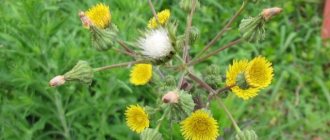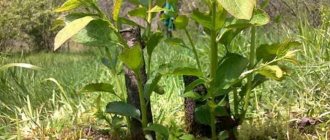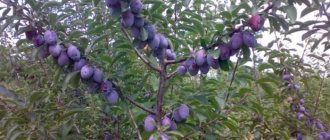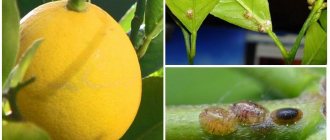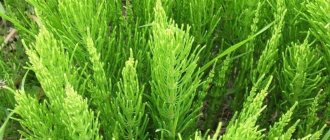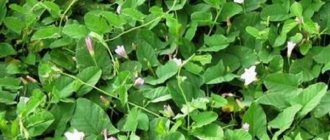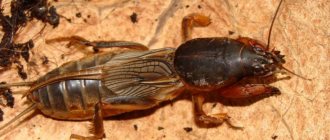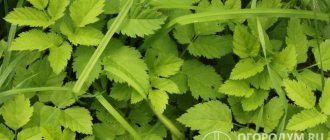Reasons for the appearance of plum growths
Plum is a self-rooted tree, so it produces much more root shoots than plants grown on seed rootstocks. The plum shoots grow rapidly, sometimes forming impenetrable jungles. Before you fight plum weed, you need to find out why it occurred.
Important! The plum tries to survive with the help of shoots, for this reason it actively forms shoots. Perhaps the plum is affected by pests (aphids, caterpillars, silkworms, moths, sawflies, etc.) or it is sick from improperly applied fertilizers. Therefore, the growth should alert the summer resident.
The main causes of root shoots include:
- Exposed root.
- Injured root system.
- Tight bandage in the grafting area.
- Inconsistency between rootstock and scion.
- Total plum pruning.
Note! Root rotting due to heat or drought will also lead to the development of wild shoots.
Causes of the problem
It must be emphasized that there are no varieties of plums without shoots - everyone has it, just some in smaller quantities, and some in larger quantities. During the season of the year, about 20 shoots of different lengths can grow.
Self-rooted trees grow 2 times more of these unnecessary shoots than a plum growing on a seed rootstock. The shoots that have arisen from the rooted varietal plum can be used as seedlings for propagation. All other shoots coming from the root are completely useless and must be removed.
Why does growth occur?
There are a number of reasons for this. The main ones include the following:
- The roots of the plum tree are exposed. This can happen if, when planting a seedling, it is not buried enough in the ground. Roots can be exposed during careless watering with a hose with strong water pressure.
- The tree has damaged roots. In this case, the reason may also be that the plum seedling was not planted deep enough. Horizontal roots are located in close proximity to the surface of the earth and can be damaged when digging the soil or weeding. Near the injured area, shoots begin to grow from the root buds.
- Wrong harness. When grafting is performed, the rootstock and scion are tied with tape. Over time, the stem of the plant thickens, the tying tape forms a constriction of wood. Because of this, the supply of nutrition from the roots to the leaves is interrupted, and a protective reaction occurs, as a result of which the growth of new root shoots is activated.
- The rootstock and scion are incompatible. If these two parts of the plant turn out to be incompatible, the metabolism between the vegetative part of the plum and the roots is disrupted. Because of this, the roots are depleted, and in order to survive the tree sprouts shoots.
- Pruning the crown of a plum tree is not according to the rules. If a tree is pruned too much, insufficient food is supplied to the roots. To compensate for this deficiency, new root shoots arise.
- Frost and drought. With severe frosts in winter and summer drought, freezing of the roots can occur and they are suppressed by high temperatures. As a result of this, new shoots also begin to grow intensively from the root.
Shoots growing abundantly from the roots should alert the gardener, since this is a self-preservation reaction of the plum tree. This may occur due to tree disease, severe pest damage, or a one-time application of a large dose of fertilizer.
Why are shoots removed?
If these shoots were harmless, then they could not be removed, but wait for them to grow and begin to bear fruit. However, they are still cut out, and for the following reasons:
- the abundance of teenagers takes a lot of nutrition from the mother tree;
- the main tree, receiving less nutrition, reduces the yield and quality of fruits;
- for perfectionists, a plum garden overgrown with unnecessary shoots loses all beauty and attractiveness.
Why remove growth?
Many gardeners do not understand why they should destroy plum shoots, because after a few years they will turn into a full-fledged crop that will produce an additional harvest. However, plum weeds need to be gotten rid of for many reasons. The shoots not only spoil the beautiful appearance of the garden, but also take away nutrients from the plum itself. And all because they have a common root.
Aboveground shoots feed during the growing season, absorbing a significant amount of vital substances. This leads to the fact that the shoots impair the nutrition of the tree and also reduce the yield. In addition, if you let the plum grow, it will be very difficult to get rid of it. That is why it is necessary to systematically deal with wild plum shoots.
On a note! The plum tree, which appeared from its own rooted fruit tree, is successfully used for propagation. And the shoots that appear from grafted game or on a trunk must be systematically removed.
How to deal with plum shoots
Below are four ways to destroy root shoots, as well as their pros and cons:
- Cutting a plum with a saw. Easy to use method. However, the effect is not long-term.
- Felling. A more complex method than sawing. But it will help you forget about the problem associated with overgrowth for a long time.
- Chemical treatment. Acts quickly and effectively. Minus: it is prohibited to use chemicals if there are fruit-bearing plants near the plum.
- Insulation. Destroys shoots in a short time. Disadvantage: the shelter is not very aesthetically pleasing.
So, the shoots need to be trimmed regularly. This event is usually carried out either in early spring or late autumn. But the problem is that frozen soil and unmelted snow often prevent gardeners from getting rid of root shoots at their base (on a horizontal root system). Experienced summer residents advise getting rid of the plum tree with a saw. You cannot use scissors or a knife to cut off the shoots, as the plum may be injured and weakened.
Often, summer residents are forced to use pruning shears to get rid of thickets of wild above-ground shoots. The shoots are cut at the level of the surface layer of soil. But this method is not good enough. If pruning was carried out in the spring, then the protruding stumps from the pruned shoots thicken and after a few months several plum bushes form.
You can properly remove wild plum growth by cutting it down. Wild shoots are dug up to the mother root, and then cut off to the very base (if you simply cut off sprouted shoots, this will increase their formation). After clearing the plant of the plum, the resulting hole is covered with earth and then compacted.
An effective method that helps to permanently remove plum growths is to not completely get rid of it, leaving a small protruding shoot. This stump must be treated with herbicide twice per season. The procedure allows you to completely get rid of root shoots after two years. Other effective drugs: Glyphos, Tornado, Hurricane, Roundup. These compounds destroy various types of vegetation.
Advice! The shoots are processed in two ways: by spraying or brushing. It is advisable to carry out the procedure in November, when all nearby crops from the plum have been removed. It is recommended to choose a day with calm weather.
Insulation also effectively rids the plum tree of growth. To perform the procedure, draw a circle around the tree, the radius of which is 0.5 m. Cover the remaining area outside the circle with newspapers. Then pour plenty of water and then trample it with your feet. Cover everything with film and roofing felt. Pour sand on top of the structure (you can use fertile soil). After a while, flowers and grass will sprout on the filled soil. Roofing material with film will prevent the growth of the plum tree.
Serious mistakes gardeners make when fighting plum shoots
Serious mistakes gardeners make in the fight against shoots are:
- They remove the shoots at the soil level, forgetting that the growth and development of the shoots begins from the roots located horizontally under the soil.
- When cutting off mature shoots, they leave stumps, from which new shoots will form the next year, the shoots of which will be even more powerful.
- When the shoots are removed, the main root of the mother plant is injured, which leads to the appearance of a new portion of shoots.
Overgrowth prevention
The plum tree constantly produces shoots. To minimize the likelihood of its occurrence, it is necessary to follow basic rules. The following are the most effective methods for preventing the appearance of plums:
- when planted high, the root system of the crop is close to the surface layer of the earth, so it can be damaged when cultivating the soil. Plum trees will begin to rapidly sprout from the injured areas;
- When watering, you should not use a strong stream of water so as not to expose the root system or damage it mechanically;
- When grafting, it is necessary to use good quality rootstock. In this case, the plum should be under supervision. If the rootstock begins to be rejected, you need to remove it and cover the cut area with slaked lime or a special preparation;
- The grafted rootstock and scion should be tightly tied with a special tape. As a grafted plum tree grows, the binding often cuts into the xylem (tree tissue). As a result, the plum will produce a lot of shoots in order to provide itself with another source of nutrition;
It is also not recommended to dig up the soil near the plum trunk, so as not to cause mechanical injury to the bark. It is enough to slightly loosen the soil. If you injure the bark of a plum tree or trim the crown, then nutrients will begin to enter the root system in insufficient quantities.
Why growth may appear
There are quite a few factors that provoke the appearance of overgrowth. To prevent future problems from occurring, it is important to identify their causes.
Mistakes made during landing
The appearance of offspring may be due to the tree being planted too high. This entails the active development of a spreading root system, which is located near the very surface of the soil. If the grafting area gets access to the sun's rays, the rootstock will form its own crown. As a result, a lot of growth is formed.
Expert opinion
Zarechny Maxim Valerievich
Agronomist with 12 years of experience. Our best country expert.
Ask a Question
Another common mistake when planting plums is placing them in the shade of trees. If there is a lack of lighting and nutrition, the tree will try to grow at the expense of root suckers.
Traumatization of bark and branches
Violation of the rules of tree care, the influence of negative natural factors and the incidence of various diseases cause a disproportion in the supply of useful substances to the root system. This causes the plant to sprout new shoots. A plum tree may produce shoots if the shoots are not pruned correctly.
The appearance of problems is most often observed the next year after improper pruning. Basically, they are associated with insufficient treatment of damaged areas with special means. Also, shoots appear if the gardener does not remove the binding from the graft.
See also
Growing and caring for plums in open ground, how to plant them correctly
Read
Improper placement of scion and rootstock
If the rootstock is not combined with the scion, nutrient production is disrupted. However, they move incorrectly between top and bottom. It may take 1 year for the problem to be identified.
In this case, there is a risk of depletion of the root system, weakened tree growth, and premature yellowing of leaves. Also, resistance to frost often decreases and the scion thickens. To compensate for starvation, the culture forms new shoots.
How to get rid of a plum tree on your property (from an adult)
Often, summer residents need to cut down a plum tree. At first glance, such work seems easy. However, in order to get rid of plums on your own site, you need to know all the nuances of this process. Below is a detailed description of how to get rid of plums with your own hands.
Using chemicals
The first method is to remove the plum using chemicals. The method is quite simple and effective. To get rid of an adult plum, you need to use special chemicals that will destroy the root of the crop. To chemically get rid of a plant you will need:
- containers for the preparation;
- arboricidal or herbicidal solution;
- polyethylene film;
- drill;
- saw.
Professionals advise using an arboricidal composition that does not harm the environment. If it is not possible to purchase this drug, then you should take a medium-active herbicide.
Stages of the procedure:
- The plum is cut down at chest level.
- You should not immediately uproot the stump, since a living root may remain in the soil, which will sprout new growth.
- In the resulting cut, not far from the bark, you need to drill several small holes. To do this you will need a large diameter drill.
- Prepare a chemical solution. Its concentration should be intended to remove weeds. Then pour the prepared mixture into the drilled holes.
- The cut should be covered with film or plastic.
- After a week, drill a few additional holes and also pour freshly prepared chemical into them. If necessary, the procedure must be repeated after a decade.
The shoots will begin to die off, after which it will be easy to get rid of the stump.
Mechanically
Many gardeners believe that getting rid of a ripe plum in the garden is simple: just cut it off to the very root. But that's not true. The plum root system remaining in the soil, having gained strength, will produce dense shoots.
For this reason, it is necessary to adhere to this algorithm:
- The plum is cut down using the usual method. The height of the cut is chosen arbitrarily.
- If you immediately get rid of the stump, it will prevent the removal of the underground root system.
- You need to wait several months until new growth appears on the stump and around it. This will reveal the location of viable plum roots.
- They need to be excavated and disposed of mechanically.
Another option: dig up the plum tree to the roots and pull them out. Afterwards, you need to cover the cuts with oil-based paint or garden varnish. Continue this procedure until the shoots stop growing.
Important! Pouring a stump with boiling water can weaken the root of a cut plum tree. However, you cannot add salt or any chemicals to this water, as this will disrupt the chemical balance of the soil.
Removing willow and aspen growth
When root layers grow wildly, and the question arises of how to get rid of willow growth on the site, you should prepare for a long struggle. Sometimes you have to fight throughout the season. If layering comes from the main tree, herbicides cannot be used.
The mechanical method is suitable. You should carefully scrape the soil away from the roots with a hoe or hoe and cut out the shoots at the root along with the root cuttings. Cover the cut area with garden varnish. If the tree is cut down, then herbicides from the glycophosphate group will help remove the sprouts: Roundup and Tornado. Treatment should be carried out at the beginning of the growing season, when the leaves on the shoots fully open.
You cannot get rid of unwanted growth just once; at least 2-3 treatments are needed with an interval of three weeks. You can pour pesticides into holes drilled in the stump. Salt sprinkled on the surface of the stump and covered with polyethylene will also help. Sodium chloride needs to be added periodically. These same methods will be useful if you are wondering how to get rid of aspen growth on your site, because the mechanism for the formation of offspring is similar.
How to dig up a plum root
To finally get rid of an old plum tree at your dacha in the autumn, you should cut down the crown and then uproot the stump. The root system of an old tree, rooted in the ground, firmly holds the stump. Therefore, you will have to work hard.
An inexperienced summer resident will choose the easy way: he will cut off the crown of the plum tree and leave the stump. If you have a creative approach, you can harmoniously fit it into the design of your garden area. However, after some time, problems await the gardener. Young shoots will begin to sprout from the stump. If you tear it off or trim it, it will grow even more intensely. How to deal with the growth of cut plums in the garden?
Stages of work:
- Place a metal barrel that has no bottom on the plum stump (the stump will sink into the cylinder).
- Throw newspapers, dried twigs of various thicknesses and other burning materials inside.
- You should stock up on additional “firewood” in advance, which will need to be constantly thrown into a kind of “firebox” until the stump burns.
After a while, repeat the procedure 2–4 more times.
You can get rid of a plum tree stump by resorting to a chemical method. To do this, you need to make several holes in the stump. Pour a couple of handfuls of saltpeter or urea into each cavity. Tie the stump tightly with polyethylene. After several years, the stump and its root system will become rotten. In the spring, annual crops can be planted around the stump.
Removal with pruning shears
If you simply mow or cut down the growth, you will not achieve the desired result, because soon it will appear again. When injured, plum shoots will not die, as you expect, but, on the contrary, will actively grow. The more often you cut down young growth, the more it will become.
We suggest you familiarize yourself with How to make a lake on your site
It must be removed with special patience and caution. First you need to dig up the ground to the rhizome, and then carefully remove the growth with pruning shears. The top cut should be covered with oil paint and buried again in the ground.
Plum varieties without shoots
Regardless of the variety, plum trees produce shoots. However, they do this in different ways. In fruit growing, native plum species have been identified that produce a large number of wild shoots, for example:
- "Ochakovskaya yellow";
- "Common Hungarian";
- "Italian Hungarian";
- "Local red."
They produce dense and tall growth.
There are also self-rooted varieties of plums, which are distinguished by a low percentage of formation of root shoots. Let's consider the types of plum trees without shoots, these are:
- "Rencold Altana";
- "Stanley"
- "Anna Shpet"
In addition, these types of plums produce a rich harvest, and they are also resistant to the negative effects of the ecosystem.

